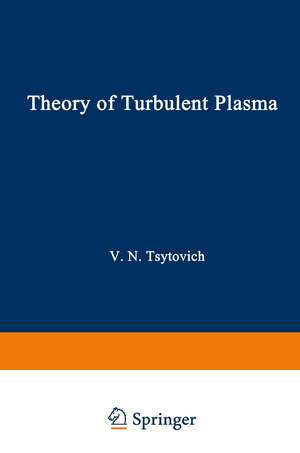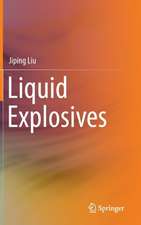Theory of Turbulent Plasma: Studies in Soviet Science
Autor V. N. Tsytovichen Limba Engleză Paperback – 27 dec 2012
Din seria Studies in Soviet Science
-
 Preț: 394.29 lei
Preț: 394.29 lei -
 Preț: 381.59 lei
Preț: 381.59 lei -
 Preț: 385.47 lei
Preț: 385.47 lei -
 Preț: 385.84 lei
Preț: 385.84 lei -
 Preț: 390.25 lei
Preț: 390.25 lei -
 Preț: 382.57 lei
Preț: 382.57 lei -
 Preț: 397.16 lei
Preț: 397.16 lei -
 Preț: 387.75 lei
Preț: 387.75 lei - 5%
 Preț: 362.88 lei
Preț: 362.88 lei -
 Preț: 387.75 lei
Preț: 387.75 lei - 5%
 Preț: 360.70 lei
Preț: 360.70 lei -
 Preț: 389.88 lei
Preț: 389.88 lei -
 Preț: 397.16 lei
Preț: 397.16 lei -
 Preț: 386.81 lei
Preț: 386.81 lei - 5%
 Preț: 366.56 lei
Preț: 366.56 lei - 5%
 Preț: 717.73 lei
Preț: 717.73 lei -
 Preț: 389.49 lei
Preț: 389.49 lei - 18%
 Preț: 726.06 lei
Preț: 726.06 lei - 15%
 Preț: 635.65 lei
Preț: 635.65 lei -
 Preț: 380.45 lei
Preț: 380.45 lei - 5%
 Preț: 363.44 lei
Preț: 363.44 lei - 15%
 Preț: 637.93 lei
Preț: 637.93 lei -
 Preț: 387.96 lei
Preț: 387.96 lei
Preț: 401.61 lei
Nou
Puncte Express: 602
Preț estimativ în valută:
76.86€ • 83.46$ • 64.56£
76.86€ • 83.46$ • 64.56£
Carte tipărită la comandă
Livrare economică 23 aprilie-07 mai
Preluare comenzi: 021 569.72.76
Specificații
ISBN-13: 9781468479256
ISBN-10: 1468479253
Pagini: 556
Ilustrații: XVII, 535 p. 30 illus.
Dimensiuni: 152 x 229 x 29 mm
Greutate: 0.74 kg
Ediția:Softcover reprint of the original 1st ed. 1977
Editura: Springer Us
Colecția Springer
Seriile Studies in Soviet Science, 1977
Locul publicării:New York, NY, United States
ISBN-10: 1468479253
Pagini: 556
Ilustrații: XVII, 535 p. 30 illus.
Dimensiuni: 152 x 229 x 29 mm
Greutate: 0.74 kg
Ediția:Softcover reprint of the original 1st ed. 1977
Editura: Springer Us
Colecția Springer
Seriile Studies in Soviet Science, 1977
Locul publicării:New York, NY, United States
Public țintă
ResearchCuprins
1. The Turbulent State of Matter: General Concepts.- 1.1. A Definition of Turbulence.- 1.2. A Statistical Description of Turbulence.- 1.3. The Spectrum of Turbulent Fluctuations in an Incompressible Fluid.- 1.4. Linear Collective Degrees of Freedom in Plasma.- 1.5. Nonlinear Collective Plasma Motions. Strong and Weak Turbulence.- 1.6. Fundamental Problems in the Physics of Turbulent Plasma.- 1.7. Turbulent Plasma in Experiment and Nature.- 2. Basic Concepts of Turbulent Plasma Theory.- 2.1. Statistical Ensemble Averages.- 2.2. Linear Effects in Changes in the Distribution of Turbulent Plasma Fluctuations.- 2.3. Nonlinear Interaction of Turbulent Plasma Fluctuations.- 2.4. The Interpretation of Nonlinear Interactions of Turbulent Fluctuations as Induced Plasmon — Plasmon and Plasmon — Plasma Particle Scattering.- 2.5. The Correlation of Turbulent Fluctuations in Plasma.- 2.6. The Quasilinear Approximation.- 2.7. Correlation of Turbulent Fluctuations and Its Effect on the Interaction with Plasma Particles.- 2.8. Turbulent Resonance Broadening of Particle — Plasmon Interactions.- 2.9. General Balance Equations for the Interactions of Particles and Turbulent Fluctuations.- 2.10. Probability Calculations.- 3. Collective Dissipation and Excitation of Turbulent Fluctuations.- 3.1. Collective Dissipation of Turbulent Fluctuations in Plasma.- 3.2. Turbulence Excitation Mechanisms.- 3.3. The Interaction of a Plasma and a Beam of Charged Particles.- 3.4. Excitation of Turbulence by Anisotropy and Loss-Cone Instabilities.- 3.5. The Excitation of Turbulence by a Constant Electric Field.- 3.6. Excitation of Turbulence in an Inhomogeneous Plasma. Drift Instabilities.- 3.7. The Excitation of Turbulence by Electromagnetic Waves and Lasers.- 3.8. The Generation of Turbulence inCosmic Plasmas.- 4. The Spectra of Stationary Plasma Turbulence.- 4.1. Types of Stationary Plasma Turbulence.- 4.2. Nonlinear Interactions and the Spectral Transfer of Energy of Langmuir Fluctuations in an Isotropic Plasma.- 4.3. The Spectra of Stationary Langmuir Turbulence in Isothermal Plasma.- 4.4. The Spectra of Low-Frequency Fluctuations Excited by Langmuir Turbulence in an Isothermal Plasma.- 4.5. Spectra of Langmuir Fluctuations in a Nonisothermal Plasma.- 4.6. Correlations and Nonlinear Frequency Shifts of Langmuir Fluctuations in Turbulent Plasma.- 4.7. The Effect of Pair Collisions of Particles on the Correlations and Spectra of Langmuir Turbulence.- 4.8. The Spectra of Ion-Acoustic Turbulence.- 4.9. The Effect of a Magnetic Field on the Interactions and Spectra of Longitudinal Plasma Oscillations.- 4.10. Spectra of Turbulence for Whistlers.- 4.11. The Spectra of Magnetohydrodynamic Plasma Turbulence.- 5. Stochastic Particle Acceleration in Turbulent Plasma.- 5.1. General Problems.- 5.2. Stochastic Acceleration of Charged Particles by Langmuir Oscillations.- 5.3. Stochastic Acceleration by High-Frequency Fluctuations in a Magnetoactive Plasma.- 5.4. Stochastic Acceleration of Particles by High-Frequency Electromagnetic Radiation in a Magnetoactive Plasma.- 5.5. Stochastic Particle Acceleration by Low-Frequency Ion-Acoustic Oscillations.- 5.6. Acceleration by Alfven Waves and Magnetoacoustic Oscillations.- 5.7. Charged-Particle Acceleration due to Induced Scattering on Turbulent Fluctuations.- 5.8. Effectiveness of Various Acceleration Mechanisms and Their Influence on Turbulence Spectra.- 6. Radiation from. a Turbulent Plasma.- 6.1. The Problem.- 6.2. Radiation Processes and the Propagation of Electromagnetic Waves in Turbulent Plasma in Terms of the StokesParameters.- 6.3. Emission of Radiation at Frequencies Close to ?pe by Langmuir Turbulence.- 6.4. Emission of Electromagnetic Waves by a Turbulent Plasma in an External Magnetic Field.- 6.5. Radiation from Epithermal and Relativistic Particles in a Turbulent Plasma.- 6.6. The Effect of Radiation from a Turbulent Plasma on the Spectra of Fast Particles.- 7. Propagation of Electromagnetic Waves through Turbulent Plasma.- 7.1. The Problem.- 7.2. General Scattering Theory.- 7.3. Scattering of Electromagnetic Waves in Turbulent Plasma.- 7.4. Amplification of Electromagnetic Waves Propagating in Turbulent Plasma.- 7.5. Fluctuations in Intensities of Electromagnetic Waves when Propagating through Turbulent Plasma.- 8. Electromagnetic Properties of Turbulent Plasma.- 8.1. General Statement of the Problem.- 8.2. Expansions of Collision Integrals in Terms of the Turbulence Energy.- 8.3. The Particle — Turbulent-Fluctuation Collision Integral: Summing The Series.- 8.4. Dielectric Permeability for an Isotropic Turbulent Plasma.- 8.5. Potential Instabilities of an Isotropic Turbulent Plasma.- 8.6. Drift Instabilities in Turbulent Plasma.- 8.7. Spontaneous Excitation of Magnetic Fields in Turbulent Plasma.- 8.8. The Skin Effect in Turbulent Plasma.- 8.9. Second Sound in Turbulent Plasma.- 9. Development of the Concepts of Strong Langmuir Turbulence.- 9.1. Introduction.- 9.2. Excitation of Strong Langmuir Turbulence.- 9.3. Solitons and Cavitons.- 9.4. Limits on the Applicability of Descriptions of Strong Nonlinear Motions and Spikons.- 9.5. Soliton and Caviton Turbulence.- 9.6. The Statistical Theory of Strong Langmuir Turbulence.- 9.7. Conclusion.- References.











